En Nigeria, muchos alumnos de centros públicos de enseñanza secundaria se enfrentan a un importante problema que afecta a su rendimiento académico: recorrer largas distancias para ir a la escuela. Este problema, que a menudo pasa desapercibido, puede tener un impacto directo en el rendimiento de los estudiantes en sus estudios. Este artículo se centra en el impacto que tiene el trekking en los estudiantes de secundaria, así como en posibles soluciones, como el transporte escolar y los programas de salud que ofrecen revisiones médicas gratuitas.
Agotamiento físico y fatiga
Uno de los efectos más inmediatos de caminar largas distancias es el agotamiento físico. Muchos alumnos de las escuelas públicas caminan varios kilómetros cada día para llegar a la escuela, a menudo iniciando el trayecto a primera hora de la mañana. Cuando llegan, ya están fatigados, lo que afecta a su capacidad para concentrarse, participar en clase y retener información. El agotamiento físico también disminuye las capacidades cognitivas, como la concentración, la retención de la memoria y la capacidad para resolver problemas.
Para los estudiantes que tienen responsabilidades domésticas adicionales, como las tareas del hogar o el cuidado de sus hermanos pequeños, la rutina diaria se hace aún más difícil. La fatiga causada por el senderismo, combinada con un descanso limitado, conduce a una disminución del rendimiento académico, ya que estos estudiantes no pueden dedicarse plenamente a sus lecciones.
Limitaciones de tiempo y hábitos de estudio
Recorrer largas distancias no sólo provoca agotamiento físico, sino que también reduce el tiempo de que disponen los estudiantes para centrarse en sus estudios. Muchos regresan a casa a última hora de la tarde, lo que les deja poco o ningún tiempo para repasar las lecciones del día o completar las tareas. Esta limitación de tiempo afecta a su capacidad para seguir el ritmo de sus compañeros, ya que el estudio personal y el repaso son fundamentales para reforzar lo que se enseña en clase.
Los estudiantes que viven más cerca de la escuela o tienen acceso al transporte están en ventaja, ya que pueden utilizar el tiempo ahorrado en los desplazamientos para centrarse en sus estudios. El tiempo que dedican cada día a desplazarse podría emplearse en hacer los deberes o descansar, dos actividades que contribuyen notablemente al éxito académico.
Implicaciones sanitarias y asistencia escolar
El esfuerzo físico que supone recorrer largas distancias también afecta a la salud de los estudiantes. La exposición a condiciones climáticas adversas como el calor, la lluvia o el polvo suele provocar enfermedades como la malaria, infecciones respiratorias o agotamiento por calor. Cuando los estudiantes enferman con frecuencia, tienden a faltar a clase, lo que provoca una baja asistencia, que repercute directamente en su rendimiento académico.
En los centros públicos de secundaria, el absentismo por enfermedad es un problema generalizado, más aún en las zonas con acceso limitado a la atención sanitaria. Cuando los alumnos enferman, no suelen recibir atención médica a tiempo, lo que prolonga su ausencia de la escuela. Este absentismo recurrente hace que se pierdan clases, lo que dificulta que los alumnos cumplan con sus responsabilidades académicas.
Tensión mental y motivación
Recorrer largas distancias también pasa factura al bienestar mental de los estudiantes. La rutina diaria de levantarse temprano y emprender un agotador viaje a la escuela genera estrés, frustración y falta de motivación. Con el tiempo, los estudiantes pueden empezar a ver la escuela como una carga más que como una oportunidad, lo que les lleva a desvincularse de sus estudios.
En las escuelas, donde los recursos ya son escasos, la tensión mental causada por el senderismo puede tener un impacto duradero. Los estudiantes desmotivados y mentalmente agotados tienen menos probabilidades de participar en clase, completar las tareas o tomarse en serio los exámenes. Este ciclo de falta de compromiso se traduce en un mayor bajo rendimiento académico.
Las escuelas secundarias públicas situadas lejos de los hogares de los alumnos se encuentran entre las más afectadas por el problema del senderismo. En muchos casos, los alumnos recorren largas distancias a pie por carreteras inseguras o en mal estado para llegar a la escuela. Esta situación no sólo supone una carga física para los estudiantes, sino que también suscita preocupación por su seguridad, ya que las niñas corren un mayor riesgo de sufrir acoso u otros peligros durante el trayecto.
Los padres de algunas comunidades se enfrentan a menudo a la difícil disyuntiva de enviar a sus hijos a la escuela a pesar de los riesgos o mantenerlos en casa, donde están seguros pero se pierden la educación. En estos casos, la larga distancia a la escuela se convierte en un obstáculo importante para la educación de los alumnos que asisten a escuelas públicas.
Posibles soluciones
Para abordar el problema del senderismo y su repercusión en el rendimiento académico de los estudiantes, se pueden considerar dos intervenciones clave: transporte escolar y programas sanitarios que ofrecen reconocimientos médicos gratuitos. Estas soluciones tienen por objeto reducir el esfuerzo físico del senderismo y abordar los problemas de salud que contribuyen al absentismo y al bajo rendimiento.
1. Transporte escolar
Introducir el transporte escolar para los alumnos de secundaria del gobierno es una de las formas más eficaces de abordar el problema del senderismo. Proporcionar autobuses escolares a los alumnos que viven lejos de la escuela reduciría en gran medida el agotamiento físico causado por caminar largas distancias. Con el transporte disponible, los alumnos pueden llegar a la escuela descansados y mejor preparados para dedicarse a sus estudios.
Los gobiernos federal, estatal o local, en colaboración con organizaciones no gubernamentales, podrían financiar y poner en marcha sistemas de transporte para las escuelas. Incluso en zonas en las que los servicios de autobús a gran escala pueden no ser factibles, soluciones a menor escala como la organización de sistemas de coche compartido o el uso de bicicletas podrían ayudar a aliviar la carga de los estudiantes. Proporcionar transporte no sólo mejoraría la asistencia a la escuela, sino también la concentración en clase, ya que los alumnos no estarían fatigados de tanto caminar.
2. Programas de salud con reconocimientos médicos gratuitos
Además de proporcionar transporte, los centros públicos de secundaria deberían poner en marcha programas de salud que ofrezcan revisiones médicas gratuitas a los alumnos. Las revisiones periódicas pueden ayudar a detectar y tratar enfermedades a tiempo, evitando ausencias prolongadas por enfermedad. Estos servicios médicos también ayudarían a identificar problemas de salud comunes, como infecciones respiratorias u otras afecciones causadas por la exposición durante las caminatas, y a tratarlos antes de que empeoren.
La aplicación de estas soluciones prácticas crearía un entorno en el que los estudiantes podrían centrarse en sus estudios sin la carga añadida del cansancio físico y los problemas de salud. Afrontar estos retos ayudará al gobierno a apoyar a los estudiantes para que alcancen su pleno potencial académico y construyan una base más sólida para el futuro.




